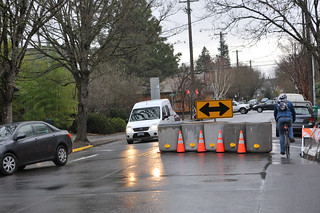On the eve of the Bureau of Transportation’s Vision Zero Action Plan going before City Council, the City of Portland just released some positive safety news: The traffic diverters installed on Southeast Clinton Street are working very well and the one at 32nd will be redesigned and made permanent in the next few weeks.
The diverters at SE 17th and 32nd were part of a comprehensive effort to tame auto traffic on Clinton that included educational outreach, public meetings, speed bumps, lower speed limits, “Bicycles May Use Full Lane” signs, and targeted enforcement. As one of the oldest and most used neighborhood greenways in the city, Clinton (which has about 3,000 bicycle users a day) was originally designed to prioritize bicycling; but driving skyrocketed in recent years as the surrounding neighborhoods added new residents, shops, restaurants and offices. In July 2014 we reported on growing rancor among bicycle users who called Clinton a “bikeway in name only.” Those concerns led community activism and became a rallying cry for the fledgling, all-volunteer bike advocacy group Bike Loud PDX.
Just four months after BikeLoud’s activism began, the City’s Bureau of Transportation launched a comprehensive assessment of the neighborhood greenway system (that would later be adopted by City Council) and agreed to meet with representatives from the group to learn more about the issues.

By the end of 2015 two diverters had been installed and PBOT converted 34th Avenue into a one-way street for driving (bicycling is allowed in both directions). People who bike on Clinton quickly noticed a change for the better in both the volume and behavior of drivers.
Now, after six months of testing, observations, and community feedback, PBOT issued a statement today calling the project “a success”. “Safety conditions have improved significantly thanks to the installation of diverters and speed bumps that have lowered traffic volumes and vehicle speeds along the Greenway,” reads the statement.
Their goal on Clinton was two-fold: reduce auto volumes to below 2,000 cars per day between SE 12th and SE Cesar Chavez Blvd (39th) and reduce the 85th percentile speed to 20 mph between Cesar Chavez and 50th. A combination of diverters and speed bumps seems to have done the trick.
Advertisement

(Graphic: PBOT)
Here are more highlights from the report (PDF):
– Recent traffic counts show that volumes on Clinton have decreased significantly across almost the entire test area, with reduction between 900 and 1,400 cars per day (-34 to -74 percent) due to the diverters, speed bumps, and other changes.
– The street segment between SE 21st and SE 26th Avenue that still exceeds the 2,000 car per day threshold is slated to get additional speed bumps in 2017 as part of an upcoming paving project.
“Neighborhood Greenways are the backbone of Portland’s bike infrastructure. If people don’t feel safe using our Greenways, they won’t use them.”
— Steve Novick, City Commissioner of Transportation
– PBOT found that the non-compliance rate for the 32nd Ave diverter is about 7 percent, which they consider normal. For people concerned about poor sight lines while cycling through it, PBOT says the new design will be better because it will have curb-high islands instead of the four-foot tall barrels in use today.
– There were no notable changes to average traffic speeds on SE Clinton. The 85th percentile speed ranged from 21 to 24 mph before the test and 19 to 24 mph after the test.
– There was a big concern about where diverted auto trips would go. Of 35 locations monitored by PBOT, only one street segment (SE Woodward, east of 31st), exceeded the total maximum volume of 1,000 cars per day.
– On SE 34th, where PBOT converted a standard two-way street into a one-way street for cars (northbound, away from Clinton) and striped a contraflow bike lane, auto volumes decreased 58 percent and only 4 percent of drivers were recorded traveling the wrong way. Not surprisingly, the new one-way street led to a slight increase in driving speeds with the 85 percentile figure going up from 19 to 21 mph.
It’s important to note that because PBOT was successful in getting most of Clinton below the 2,000 cars per day threshold, they can now trigger a state law that allows them to reduce the speed limit to 20 mph (a law that only applies on neighborhood greenways).
And PBOT isn’t done on Clinton. In addition to the permanent diverter coming to 32nd, PBOT wants to get that last pesky segment between 21st and 26th down below 2,000 cars per day (it’s just 2,005 now). To do that they’ll place speed bumps more closely together during a scheduled repaving project coming this spring. The report released today also offers a few ideas for Clinton that were beyond the scope of this project: improve the crossing at 50th to improve safety and reduce biking and walking delay; do more parking enforcement on side streets to improve sight distances; and improve the crossing at 26th Avenue “by taking advantage of excess right-of-way to ehance safety for bicyclists and pedestrians.”
The total cost of this project — including the new permanent diverter coming to 32nd — is $230,000.
That’s a “cost-effective solution” says PBOT Commissioner Steve Novick. “Neighborhood Greenways are the backbone of Portland’s bike infrastructure,” he said via today’s statement. “If people don’t feel safe using our Greenways, they won’t use them.”
Learn more about this project and download the full report here.
— Jonathan Maus, (503) 706-8804 – jonathan@bikeportland.org
BikePortland is supported by the community (that means you!). Please become a subscriber or make a donation today.


